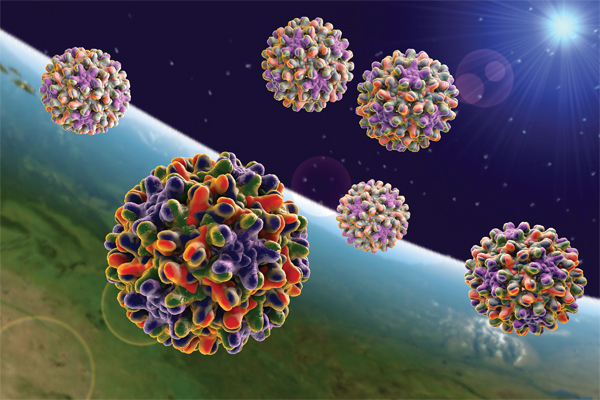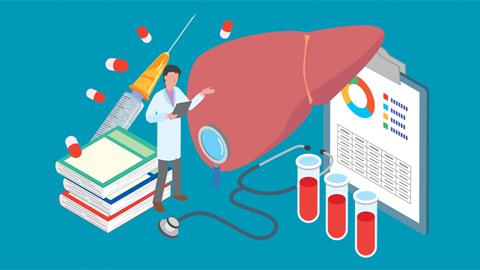From the journals: January 2018
We offer a selection of recent papers on a variety of topics from the Journal of Biological Chemistry, the Journal of Lipid Research and Molecular & Cellular Proteomics.
Alcohol consumption plus hepatitis B raises cholesterol in mice
Though a safe and effective vaccine for hepatitis B is available and used worldwide, the World Health Organization estimates that still some 257 million people are living with the viral infection. The virus is treatable but causes liver scarring and in some cases liver cancer. Intravenous drug users who share needles are especially at risk of infection and are likely to abuse multiple substances, including alcohol, which causes liver damage as well. Given that damage to the liver affects how the organ creates and clears cholesterol and given that studies have found that hepatitis B alone and alcohol alone affect cholesterol homeostasis, a research team led by Qin Ning at Tongji Hospital at Huazhong University of Science and Technology in Wuhan, China, wanted to learn more about the combined effects of hepatitis B and alcohol consumption on cholesterol deposition in the liver. In a new paper in the Journal of Lipid Research, the team reports that the virus and alcohol have a “synergistic effect” on cholesterol metabolism. That is to say that the combination increases cholesterol biosynthesis, decreases cholesterol utilization and impairs cholesterol uptake. To figure this out, the team created a mouse model with chronic hepatitis B and gave it ethanol. This resulted in increased cholesterol accumulation in the liver. Later experiments, using only cells, produced results that the researchers say indicate it is the HBc protein specifically that activates cholesterol biosynthesis and inhibits cholesterol degradation in the presence of alcohol.
 The hepatitis B virus can live outside the body and remain infectious for about a week.
The hepatitis B virus can live outside the body and remain infectious for about a week.A chemical cocktail that reprograms mouse cells
Scientists can reprogram differentiated somatic cells using transcription factors or small molecules, but the types of cells they’ve created thus far using chemical cocktails have been limited. In the Journal of Biological Chemistry, Shangtao Cao and colleagues from the South China Institute for Stem Cell Biology and Regenerative Medicine identify a combination of small molecules and growth factors that can reprogram mouse embryonic and adult fibroblasts into epithelial-like cells, an intermediate cell type capable of further differentiation. These chemical tools may enable additional advances in regenerative medicine.
Malaria vaccine development
The only available vaccine against Plasmodium falciparum, one of the causative agents of malaria, shows limited efficacy. Malaria vaccine developments face major challenges due to the significant sequence diversity of the known parasite antigens. In a study published in the journal Molecular & Cellular Proteomics, Matthias Marti and colleagues at the Harvard T.H. Chan School of Public Health aimed to overcome this problem by performing a mass spectrometry technique to profile the surface proteome of red blood cells infected with P. falciparum. The investigators identified a set of single-copy surface antigens with low sequence diversity, some of which further were validated to be immunogenic and thus potentially could be developed as vaccines.
How RNA proteins modulate phase separation
RNA granules are spots in the cell in which RNA molecules and RNA-binding proteins aggregate to carry out RNA modifications that affect gene expression. Rather than being bound by a membrane, these compartments are delineated by differences in viscosity from the surrounding cytoplasm. Phosphorylation of intrinsically disordered regions of RNA-binding proteins contributes to the assembly of RNA granules. Yuan Lin and colleagues from the University of Texas Southwestern Medical Center at Dallas write in the Journal of Biological Chemistry that tyrosine residues in these RNA-binding proteins modulate their ability to induce the liquid-liquid phase separation process that leads to RNA granule formation and that the phase-separation threshold depends on the number of phosphorylated tyrosines. These insights show how proteins can modulate the properties of fluids inside the cell, potentially influencing how genes are expressed.
What prion protein does when it’s not wreaking havoc
Misfolding of prion protein, or PrP, causes prion diseases, including bovine spongiform encephalopathy (more commonly known as mad cow disease) and the human Creutzfeldt-Jakob disease. However, the physiological function of normal, nonpathogenic PrP is poorly understood. Gui-Ru Wu and colleagues at the Chinese Academy of Sciences examined the role of normal PrP in two cancer cell lines and showed that it was critical for signaling through the tumor necrosis factor alpha pathway. Their findings were published in the Journal of Biological Chemistry. PrP sequestered the tumor-suppressor protein CYLD, resulting in proinflammatory cytokine production. Thus, normal PrP may be involved in both immune responses and tumor progression.
MAPping the kinase targets in Arabidopsis
The mitogen-activated protein kinases, or MAPKs, play important roles in regulating cellular processes. In the plant Arabidopsis, little is known about the functions of MAPK family members MPK3, MPK4 and MPK6, especially in cell division, growth, development and innate immunity. In a study in the journal Molecular & Cellular Proteomics, Heribert Hirt and colleagues from King Abdullah University of Science mapped the substrates of these kinases by performing a phosphoproteome analysis on wild-type plants and plants that have mutations in any of the three MAPK genes. The investigators identified and validated a number of novel MAPK targets that either were shared by or specific to each of the three MAPKs, increasing the repertoire of known MAPK substrates.
 Arabidopsis thalianacourtesy of Alberto Salguero Quiles/Wikimedia Commons
Arabidopsis thalianacourtesy of Alberto Salguero Quiles/Wikimedia CommonsThe cholesterol connection
to rare muscle-wasting disorders
Rare inherited mutations in the DYSF gene cause deficiencies in the protein dysferlin, resulting in debilitating limb-girdle muscular dystrophy type 2b. To date, there are no approved therapies for dysferlinopathies. Drug development has been slowed, in part, by the lack of animal models that closely mimic human symptoms. A new paper in the Journal of Lipid Research, however, reports the creation of a mouse that comes closer than its predecessors and contemporaries. A research team led by Pascal N. Bernatchez at the University of British Columbia set out to create the new mouse model after observing that elevated so-called bad cholesterol levels correlate with disease severity in some muscular dystrophy patients. While mice with the DYSF gene knocked out display muscle degradation, they usually don’t lose the ability to walk, as human patients do. Bernatchez’s team knocked out both the DYSF gene and the APOE gene in their mice. Loss of apolipoprotein E function increases bad cholesterol. The team’s double-knockout mice developed more dramatic muscle wasting than mice with only DYSF knocked out and eventually were unable to walk. The researchers hope their new model will help scientists better understand the human disease. Importantly, the researchers wrote, though it’s unclear at this stage precisely how bad cholesterol exacerbates muscle damage, their model revealed “a striking correlation” that deserves further investigation. The work was supported by the Jain Foundation.
Splice variants with opposite effects
on metastatic breast cancer
Triple-negative breast cancers lack the three receptors that the most effective treatments today target, making a triple-negative diagnosis quite devastating. In the Journal of Biological Chemistry, James DeLigio and colleagues from the Virginia Commonwealth University write that they examined the effects of downregulating two forms of a protein in triple-negative breast cancer cells. Cytoplasmic polyadenylation element binding protein 2, or CPEB2, is a translational regulator that has two isoforms derived by alternative splicing, one of which is upregulated in aggressive metastatic breast cancers. In the researchers’ study, the two isoforms had opposite regulatory effects on pathways involved in epithelial-to-mesenchymal transition and hypoxic response, processes that contribute to invasiveness, with the cancer-associated isoform upregulating these pathways’ activities and the other isoform downregulating them. The cancer-associated isoform of CPEB2 appeared to exert this effect by enhancing the translation of the transcription factors TWIST1 and HIF-1alpha, both of which have been implicated in cancer.
How malaria parasites get around in multiple hosts
The malaria parasites, which belong to the genus Plasmodium, have multiple stages in their life cycles in both mammalian and insect hosts. Judith Green and colleagues at the Francis Crick Institute in London are studying the life-cycle stages of Plasmodium berghei, which causes malaria in certain rodents and is used as a model for the human malarias caused by four of its parasitic kin. Green’s team reported in the Journal of Biological Chemistry that it had characterized the components of the glideosome — a membrane-associated molecular motor that P. berghei uses for motility and to invade hosts— across all the life cycle stages. The researchers identified a myosin light chain in the glideosome that previously was unknown in malaria parasites and showed that the presence of this chain doubled the parasite’s sliding velocity in vitro.
Understanding arginine phosphorylation
Phosphorylation has been studied widely in terms of its modifications on serine, threonine and tyrosine amino acids. Even though phosphorylation is known to occur on arginine residues, its extent and effects are a lot less studied. Investigators at the University of Greifswald in Germany, led by Dorte Becher, examined the arginine phosphoproteome of the Gram-positive bacterium Staphylococcus aureus artificially lacking the PtpB gene, a putative arginine phosphatase. Using a classical mass spectrometry database search and spectral libraries of synthetic arginine phosphorylated peptides, the investigators identified 207 arginine phosphosites in S. aureus, which could allow further investigation of the physiological relevance of arginine phosphorylation in bacteria. The study was published in the journal Molecular & Cellular Proteomics.
A silver lining to obesity-induced neuronal damage
Melanocortin-4 receptors are expressed in the brain and are part of the insulin- and leptin-sensing pathways that regulate appetite and energy expenditure. MC4R agonists cause overweight mice to consume less food, but prolonged agonist binding leads to desensitization. Kimberly Cooney and colleagues from the University of Arkansas for Medical Science write in the Journal of Biological Chemistry that palmitate-induced neuronal injury, a common complication of obesity, impaired the endocytosis of agonist-bound MC4R, decreasing desensitization. This suggests that neuronal stress experienced during obesity may unexpectedly increase the effectiveness of MC4R agonists.
Nipping a cancer-related protein in the bud
Matrix metalloproteinases, or MMPs, are enzymes involved in signaling and tissue remodeling. They frequently are dysregulated in cancers and other diseases, but attempts to find selective MMP inhibitors have been largely unsuccessful. In the Journal of Biological Chemistry, Robert Scannevin and colleagues at the pharmaceutical company Janssen Research and Development report a new inhibitor that targets MMP-9 by allosterically inhibiting activation of the MMP-9 zymogen. The inhibitor reduced the severity of autoimmune encephalomyelitis in mice.
A ubiquitous signaling protein regulates alternative splicing
Glycogen synthase kinase-3, or GSK-3, is a ubiquitous, constitutively active signaling protein whose targets have not been characterized comprehensively. Mansi Shinde and colleagues at the University of Pennsylvania performed unbiased phosphoproteomic characterization of mouse embryonic stem cells with and without the GSK-3 gene and found that, among other targets, GSK-3 consistently targeted RNA splicing factors. Absence of GSK-3 changed the splicing patterns of hundreds of RNAs, revealing a previously unknown role of the enzyme. The results were published in the Journal of Biological Chemistry.
Enjoy reading ASBMB Today?
Become a member to receive the print edition monthly and the digital edition weekly.
Learn moreGet the latest from ASBMB Today
Enter your email address, and we’ll send you a weekly email with recent articles, interviews and more.
Latest in Science
Science highlights or most popular articles

Iron could be key to treating a global parasitic disease
A study has found that leishmaniasis causes body-wide changes in iron balance, leading to red blood cell damage.

Environmental DNA is everywhere
The ability to extract trace bits of DNA from soil, water, and even air is revolutionizing science. Are there pitfalls?

Early COVID-19 research is riddled with poor methods and low-quality results
The pandemic worsened, but didn’t create, this problem for science.

From the journals: MCP
Three views of mass spec: analyzing secreted protein spectra, imaging mass spectrometry for clinical use and spectral libraries for MS data analysis. Read about these recent papers.

Understanding the fat science
Researchers at UCLA investigate lipid remodeling in the liver for energy generation.

No oxygen? No problem
By studying how electric fish survive in hypoxic streams for months at time, researchers may find new ways to target tumors.

.jpg?lang=en-US&width=300&height=300&ext=.jpg)

